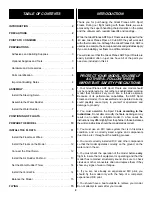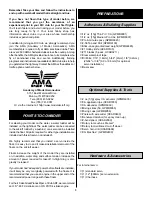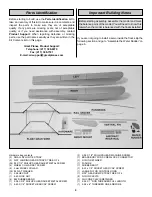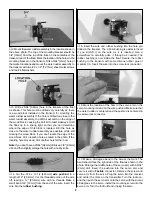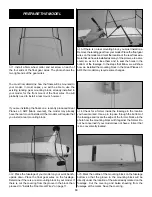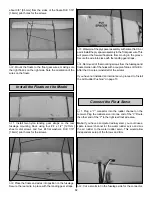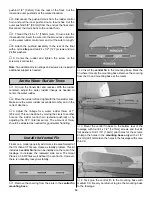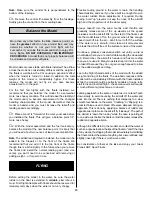
❏
8. Cut a small notch in the servo hatch for the servo
extension wire. Install a 12" servo extension wire on the
servo lead. Secure the connection with tape, keeping the
connection as water tight as possible. Position the servo
hatch onto the rails with the taped connection inside the
float. Secure the hatch into place with some clear
waterproof tape. Put a dab of silicone glue where the servo
wire exits the hatch to waterproof it.
Before you continue, take a break from building and
study the following information to be sure you
understand the positioning of the floats in relation to
the wing and fuselage.
While the following instructions show the Sport Floats on
Great Planes Piper Cubs, there are general tips and
guidelines that apply to all models which will insure proper
handling characteristics in the water and good landing and
takeoff tendencies.
The relationship between the “step” on the floats and the
center of gravity on the model is important. First, the floats
should be mounted on the model so the step is positioned as
detailed in the “Step Sketch” for your particular model. Then,
when the floats are mounted on the model, move the C.G.
slightly forward as listed below. Although you may have added
the recommended ballast inside the front of the float, in some
cases a little more ballast may be required on the model.
• For 60-size floats: Move the CG (Balance point) 1/2"
ahead of the manufacturers recommended CG.
• For 40-size floats: Move the CG (Balance point) 3/8"
ahead of the manufacturers recommended CG.
• For 20-size floats: Move the CG (Balance point) 9/32"
ahead of the manufacturers recommended CG.
Another important relationship between the wing and the
floats is the relative “angle of attack.’’ With a virtually flat
bottom wing such as a Piper Cub, the deck of the floats
should be parallel to the bottom of the wing. Since the Cub
does not have a truly flat wing, this yields a slight positive
wing incidence in relation to the floats, and the airplane will
tend to rise off the water at the correct time. If you have a
model with a symmetrical wing, the wing incidence in
relation to the float deck should be positive 1-1/2 degrees.
Finally, each float should be set so that it is parallel to the
centerline of the fuselage.
POSITIONING OF FLOATS
9


